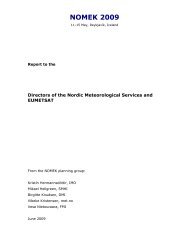International Symposium on Mitigative Measures against Snow ...
International Symposium on Mitigative Measures against Snow ...
International Symposium on Mitigative Measures against Snow ...
Create successful ePaper yourself
Turn your PDF publications into a flip-book with our unique Google optimized e-Paper software.
<str<strong>on</strong>g>Internati<strong>on</strong>al</str<strong>on</strong>g> <str<strong>on</strong>g>Symposium</str<strong>on</strong>g> <strong>on</strong> <strong>Mitigative</strong> <strong>Measures</strong> <strong>against</strong> <strong>Snow</strong> Avalanches<br />
Egilsstaðir, Iceland, March 11–14, 2008<br />
areas, roads and other places where more frequent avalanches are acceptable than around<br />
settlements. The hazard mapping process for ski areas is in many ways different from e.g.<br />
hazard mapping for settlements. Due to the proximity of avalanche starting z<strong>on</strong>es to<br />
c<strong>on</strong>structi<strong>on</strong>s and ski-paths, smaller release areas and more frequent events in known<br />
avalanche paths have to be c<strong>on</strong>sidered. The primary result of exploratory simulati<strong>on</strong>s of small<br />
to medium-size Icelandic avalanches is that they can be simulated with reas<strong>on</strong>able realism<br />
with samosAT.<br />
This approach is based <strong>on</strong> a classificati<strong>on</strong> of the release areas with respect to their physical<br />
properties such as inclinati<strong>on</strong>, aspect and shape. The release areas are assigned a single<br />
number referred to as the starting z<strong>on</strong>e index and are thereby ranked by their likelihood of<br />
releasing an avalanche with a comparatively large run-out. It is not the goal to fully automate<br />
the hazard z<strong>on</strong>ing process. The method is rather an attempt to provide some overview of the<br />
avalanche c<strong>on</strong>diti<strong>on</strong>s of the area under scope and establish a basis for further analysis.<br />
3.3 Design of deflecting dams<br />
The effects of deflecting dams can by assessed with two-dimensi<strong>on</strong>al avalanche models by<br />
simulating the flow of an avalanche with given parameters using digital terrain model that<br />
includes the structure of c<strong>on</strong>siderati<strong>on</strong> and compare it to equivalent simulati<strong>on</strong> <strong>on</strong> untouched<br />
ground. The run-out index scale is useful to determine an appropriate design avalanche and to<br />
simulate the performance of the structure as the events gradually become larger.<br />
Figure 4 Distributi<strong>on</strong> of 2D run-out indices around the opening of the Hnífsdalur-Bolungarvík<br />
tunnel with (blue curves) and without (purple curves) the deflecting dam.<br />
The extent of the January 2005 avalanche is shown as a red curve.<br />
The samosAT has been run to c<strong>on</strong>strain the design of a deflecting dam in relati<strong>on</strong> to a c<strong>on</strong>structi<strong>on</strong><br />
of a road tunnel c<strong>on</strong>necting Hnífsdalur and Bolungarvík in the northwestern part of<br />
Iceland. The planned locati<strong>on</strong> of <strong>on</strong>e of the openings of the tunnel is in an area with well<br />
known history of avalanches. An avalanche recorded in January 2005 was chosen as a<br />
reference event. It reached the 2D run-out index 13 and has an estimated return period of<br />
approximately 15 years.<br />
Gíslas<strong>on</strong> 167











